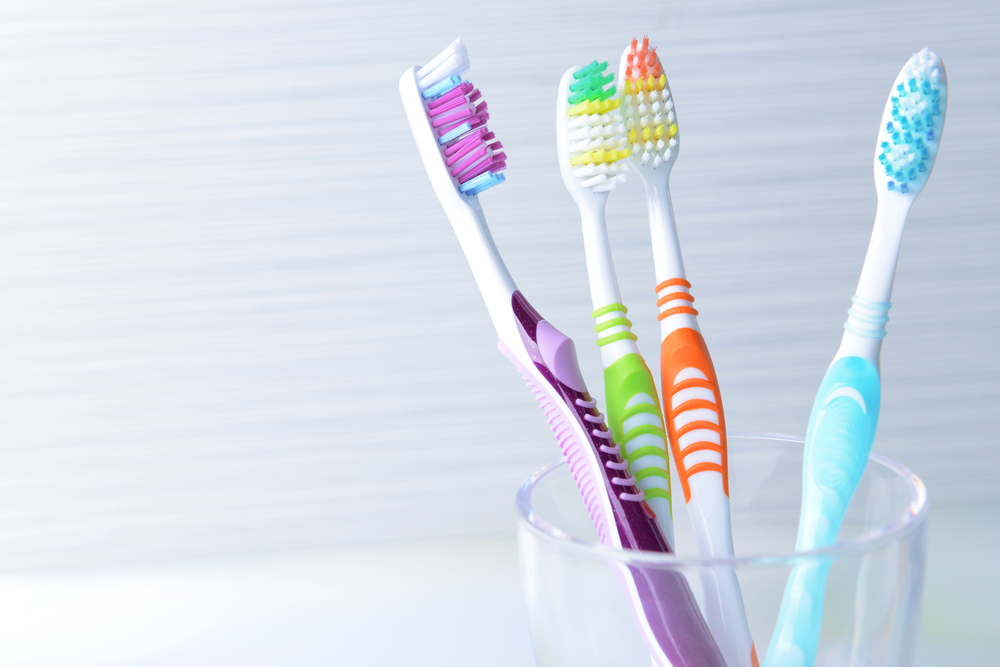
We talk a lot about brushing teeth. After all, brushing your teeth twice a day is an important way to prevent tooth decay and gum disease, as well as keep bad breath at bay. But, what about how to store your toothbrush? This is what a patient, Lucee, wanted to know when she sent the following email to a Naperville dentist at our practice, which we’re sharing with her permission:
“My boyfriend bought some of those plastic toothbrush cases to keep our toothbrushes in, but I noticed that they feel soggy in the morning. I always kept my toothbrush upside down in Listerine overnight. My mom keeps hers in a toothbrush holder and lets it dry, but to me, there are too many gross bathroom germs to do that. What’s the best way to store our toothbrushes? Thanks, Lucee”
All of the toothbrush storage ideas mentioned by Lucee might sound okay. After all, is there really a right and wrong way to store your toothbrush? Actually, there is! Proper toothbrush storage will keep your toothbrush sanitary and prevent the growth of bacteria.
In this post, we’ll cover:
- Where to store your toothbrush
- How to store a toothbrush
- 5 extra steps to take for sanitary toothbrush storage and use
Where to Store Your Toothbrush
While Lucee didn’t ask specifically about where to store a toothbrush, we thought we’d talk about this first since there’s a lot of debate about whether or not to store a toothbrush in the bathroom.
Yes, your bathroom contains your toilet and, as you may have read in recent years, there is such a thing as toilet plume. Toilet plume is the aerosolized cloud of microscopic particles that goes into the air and nearby surfaces when you flush the toilet.
While there isn’t a standard distance for how far toilet plume reaches, keeping your toothbrush right next to your toilet probably isn’t the best toothbrush storage idea. However, there’s no need to leave your toothbrush in an entirely different room of the house. After all, in reality, your toothbrush isn’t sterile, even when it comes out of the package.
Additionally, according to the American Dental Association, though toothbrushes have been found to harbor bacteria, including bacteria from toilet flushing, there is no evidence that these bacteria cause adverse health effects. And while research suggests there could be some risk for the transmission of certain viruses, including norovirus, from the toilet particles after flushing, this transmission is based on the viral particles in the air and hasn’t been tied directly to toothbrushes.
So, while it’s likely more of the gross factor and less of a health threat, when it comes to how to store toothbrushes in the bathroom to avoid germs, your best bet is to simply keep your oral hygiene supplies as far from the toilet as you can.
How to Store a Toothbrush
Now, on to answering Lucee’s question about how to store a toothbrush. Though using a toothbrush case in the bathroom or putting your toothbrush in the medicine cabinet might seem like an appropriate tactic for keeping it safe from toilet plume, it’s actually not the best way to store a toothbrush.
Instead, let your toothbrush air dry completely between uses to prevent bacteria growth. To do this, store it upright and uncovered. Ideally, if you can, put your toothbrush by an open window as it dries. If you store your toothbrush in a plastic case, in a cabinet or in a covered toothbrush holder, you’re creating the ideal conditions for bacteria and mold to thrive, and no one wants a germ-covered, moldy toothbrush.
Will a toothbrush stand do the trick? Toothbrushes shouldn’t be stored touching or in close proximity in an open container, holder or stand because cross contamination can occur. Therefore, a multi-brush stand that’s crammed with the entire family’s toothbrushes isn’t recommended. That said, a toothbrush holder is fine as long as yours is the only toothbrush in it or the brushes are spaced far apart, and it’s open, ensuring your toothbrush head is able to air dry.
What about how to store an electric toothbrush? The basics for how to store an electric toothbrush, bamboo toothbrush or conventional, manual toothbrush are the same. Since electric toothbrushes tend to be a bit bigger and you still want the toothbrush to be upright to air dry, storing it in a cup or a stand with a big enough opening to dry between brushing sessions will be helpful.
5 Tips for Sanitary Toothbrush Storage and Use
- After using your toothbrush, rinse it thoroughly with water to remove food debris and excess toothpaste before putting it away.
- Soaking your toothbrush head in an antibacterial mouthwash as Lucee suggested can decrease bacteria growth. After soaking it for about 15-20 minutes, rinse it off, and let it air dry. Use a clean container to soak the toothbrush so cross contamination doesn’t occur.
- Never share toothbrushes with anyone else.
- If you’re concerned about toilet plume, or someone in your household is ill, make it a habit to close the toilet lid before flushing. This will prevent the particles from escaping in the air and coming into contact with your toothbrush.
- Replace your toothbrush or electric toothbrush head about every three months. If the bristles look frayed, replace it sooner. Worn bristles don’t clean teeth effectively.
Now that you know the best way to store your toothbrush, don’t overthink it or worry too much. As long as you allow your brush head to air dry, it’s not touching other toothbrushes and you replace your toothbrush every three months, you’ll be fine. The risk of not brushing your teeth is a whole lot greater than the risk of brushing with a toothbrush that’s been sitting out in a bathroom. If you have any additional oral hygiene questions or you’re looking for expert cosmetic dentistry, general dentistry or specialty care in Naperville, schedule a visit at Naperville Dental Specialists today!

































